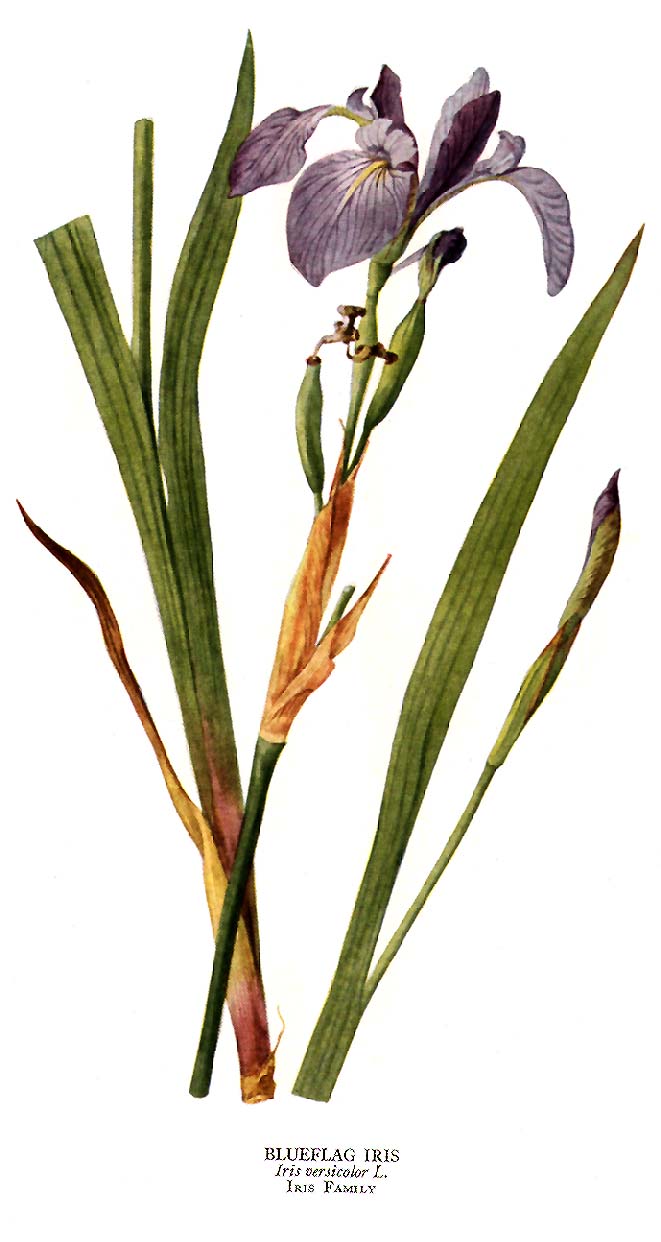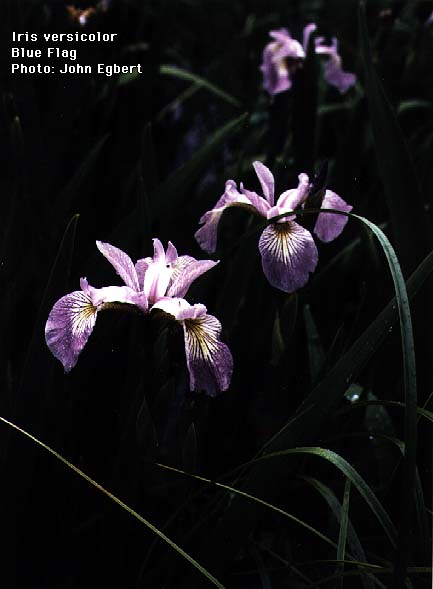
Iris versicolor poisoning
General poisoning notes for Iris versicolor
Blue flag (Iris versicolor) is a native herb found in eastern and central Canada. This plant has been mentioned as causing poisoning in humans and animals, but case reports have not been found. The plant juice can cause dermatitis in sensitive individuals. Other iris species have also been implicated in poisoning of animals and in causing dermatitis in humans (see additional information under Iris pseudacorus). Because of the potential for poisoning, care should be taken to prevent access by livestock to blue flag, which grows in moist soils near rivers, lakes, and marshes (Fyles 1920, Cooper and Johnson 1984).
Nomenclature
Botanical name: Iris versicolor L.
English Common name: blue flag iris
French Common name: clajeux
Botanical family name: Iridaceae
English family name: iris
Toxic parts = rhizome
Notes on toxic chemicals
A glycoside, iridin (or irisin), has been implicated as the toxic compound in iris species, although this has not been confirmed (Fyles 1920, Cooper and Johnson 1984).
Toxic chemicals = iridin
Diseases of Humans = Dermatitis
![]()

Iris
"Blue Flag Iris"
Iris versicolor
I. cristata (crested iris); I. douglasiana (Douglas iris, mountain iris); I. verna (vernal iris); I. versicolor (blue flag iris) Wild irises are perennials that grow in swamps, wet meadows and moist woods throughout North America. Like their cultivated relatives, they are easily identified by their flat, sword-shaped leaves and distinctive flowers. Each blossom consists of three erect petals and three larger outer petal-like sepals, usually the same color as the petals, which ordinarily curve downward from the base of the flower and are marked with crests of a contrasting color. The striking flowers bloom from spring through early summer in a very wide range of colors, often in combinations--and are aptly named after the Greek goddess of the rainbow.
The crested iris is a dwarf species, growing primarily in the southeastern United States, with 2-inch-wide purple or white flowers that have a conspicuous, fringed white crest. These nearly stemless plants grow 3 to 8 inches tall with leaves up to 12 inches long. The Douglas iris, native to California and southwestern Oregon, grows 6 to 30 inches tall and bears cream to red-purple flowers. Vernal iris, a dwarf species only 6 inches tall, has early-blooming violet flowers with a yellow or orange lengthwise band on each sepal and 1/2-inch-wide, foot-long leaves that often become black and leathery as they age. This species is found in the Southeast, and is sometimes considered one of the more difficult to grow in the garden. The most familiar wild iris, the blue flag is, unlike its tiny relatives, a robust plant 2 to 3 feet tall, similar to the cultivated iris. The thick, bladelike foliage forms dense masses, and the erect flowers, 3 inches wide, make a colorful summer display in the northeastern and north central states.
HOW TO GROW. The crested iris grows in the Deciduous Woodland environment. This species will spread to form a ground cover and grows well in sun or high open shade in soil with a pH of 6.0 to 7.0. The Douglas iris grows in the Western Coniferous Woodland environment. It does well in full sun or light shade in well-drained soil with a pH of about 7.0. The vernal iris is suited to the Deciduous and the Southeastern Coniferous Woodland environments. It does best in open shade and moist, sandy soil with a pH below 5.0. The blue flag grows in the Northeastern Coniferous Woodland environment. It needs full sun and moist soil with a pH of 6.0 to 7.0. Irises are best grown from divisions of roots or rhizomes; plants started from seed can take up to three years to bloom. In the spring or fall, place roots or rhizomes 6 to 12 inches apart barely below the surface of the ground so that the tip is just at soil level. Keep the ground moist. To propagate irises from seeds, sow the seeds in moist peat moss in flats in the fall. When seedlings appear the following spring, transplant them to a protected nursery bed and grow them there for a year before moving them to a permanent location. All species but the vernal irises reseed themselves readily if left undisturbed in congenial surroundings.
![]()
![]()
Back to Plants
 Wildflower
Seed For Sale
Wildflower
Seed For Sale